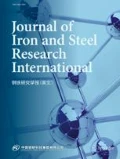Abstract
A theoretical model adapted for studying steel continuous casting technology was proposed. The model based on system theory contained input/output, command, and control parameters. The process was divided into five stages, i. e., tundish, mold, guiding system, guiding-drawing system, and guiding-drawing-soft reduction system. The model can be used to describe the physicochemical processes, thermal processes, chemical processes, and characteristics of the cast material according to the above-mentioned stages. It can also be applied to other metallurgical technologies and even to other industries (chemistry, food, etc.).
Similar content being viewed by others
References
Presslinger H, Mayr M, Tragi E, et al. Assessment of the Primary Structure of Slabs and the Influence on Hot- and Cold-Rolled Strip Structure [A]. VDEh Steel Institute, ed. Proceedings of the 1st Chinese-German Metallurgy Seminar on Fundamentals of Iron and Steelmaking [C]. Beijing: The Chinese Society for Metals, 2004. 196.
Barber B, Bush A W, Tunstall J P. Strand Straightening in the Continuous Casting of Steel [J]. IMA Journal of Management Mathematics, 1996, 7(2): 181.
Zaharia C, Crudu I. Study and Researches Regarding the Lubrication and Cooling During Hot Strip Milling [A]. University Dunarea de Jos, Galati ed. Proceedings of the National Tribology Conference With International Participation, ROTRIB’03 [C]. Galati, Dunarea de Jos University, 2003. R30.
Azzouz A, Gheorghies C. Modelling in the Industrial Design [M]. Galati, Evrika, 1999 (in Romanian).
Crudu I, Ivanescu Al, Stefanescu I. Tribosystems for Integrate Manufacturing Processes in Metallurgical Industry [A]. Sireteanu T, ed. Proceedings of the Annual Symposium of the Institute of Solid Mechanics, SISOM [C]. Bucharest: Romanian Academy of Technical Science, 2006. R30.
Kajitani T, Drezet J M, Rappaz M. Numerical Simulation of Deformation-Induced Segregation in Continuous Casting of Steel [J]. Metallurgical and Materials Transactions A-Physical Metallurgy and Materials Science, 2001, 32(6): 1479.
Minzu V, Lang B. Automatic Command of the Continue Linear Systems [M]. Paris: Ellipses Edition Marketing, 2001 (in French).
Morwald K, Thalhammer M, Federspiel C, et al. Metallurgical, Operational and Economic Benefits of SMART/ASTC Technology in Continuous Casting [J]. Journal of Metallurgy, 2004, 4: 301 (in French).
Noblot A, Sutter P, Wimmer F, et al. Application of DIA-MOLD High-Speed Casting Technology at ISPAT [J]. Journal of Metallurgy, 2001, 4: 367 (in French).
Li C, Thomas B G. Analysis of the Potential Productivity of Continuous Cast Molds [A]. Irons G, Cramb A, eds. Brimacombe Memorial Symposium [C]. Vancouver: Met Soc, 2000. 595.
Thomas B G. Modeling of the Continuous Casting of Steel: Past, Present and Future [J]. Metallurgical and Materials Transactions, 2002, 33B(6): 795.
Filipic B, Robic T. A Comparative Study of Coolant Flow Optimization on a Steel Casting Machine [A]. Garrison Greenwood, ed. Proc IEEE Congress on Evolutionary Computation (CEC 2004) [C]. Portland: IEEE Press, 2004. 569.
Thomas B G. Modeling for Casting and Solidification Processing [M]. New York: Yu O and Marcel Dekker Editor, 2001.
Fedakova D, Marek P. Utilization of a Numerical Model of the Temperature Field of a Continuous-Casting and Prediction Anti-Break Systems at the Continuous Caster of the Steelworks Division Plant to Improve the Production Quality at U S Steel Kosice, Ltd [J]. Acta Montanistica Slovaca, 2003, 8(4): 168.
Köhl R, Mörwald K, Pöppl J, et al. The Dynaflex Oscillator—A Technology Breakthrough in Billet Casting [J]. Journal of Metallurgy, 2001, (1):75 (in French).
Dauby P H, Assar M B, Lawson G D. PIV and MFC Measurements in a Continuous Caster Mould. New Tools to Penetrate the Caster Black Box [J]. Journal of Metallurgy, 2001, (4): 353 (in French).
Chunsheng Li, Thomas B G. Thermo-Mechanical Finite Element Model of Shell Behavior in the Continuous Casting of Steel [A]. International Journal of Surface Science and Engineering, ed. Sixth Asia-Pacific Symposium on Engineering Plasticity and Its Applications [C]. Sydney: NSW Trans Tech, 2002. 827.
Ungureanu St. Sensibility of Dynamic Systems [M]. Bucharest: Technical Publishing House, 1988.
Crudu I, Ionescu M P, Munteanu V, et al. A Tribosystemic Approach to Refractory Lining Destruction in Blast Furnaces [J]. Wear, 1998, 216(2). 251.
Gheorghies C. Structural Changes During Friction, Wear and Fatigue Processes [M]. Bucharest: Technical Publishing House, 1994 (in Romanian).
Crudu I. A Principle of Tribosystemation and Tribomodeling [R]. Galati: The Annals of Dunarea de Jos University, 1999.
Author information
Authors and Affiliations
Corresponding author
Rights and permissions
About this article
Cite this article
Gheorghies, C., Crudu, I., Teletin, C. et al. Theoretical Model of Steel Continuous Casting Technology. J. Iron Steel Res. Int. 16, 12–16 (2009). https://doi.org/10.1016/S1006-706X(09)60003-0
Revised:
Published:
Issue Date:
DOI: https://doi.org/10.1016/S1006-706X(09)60003-0




